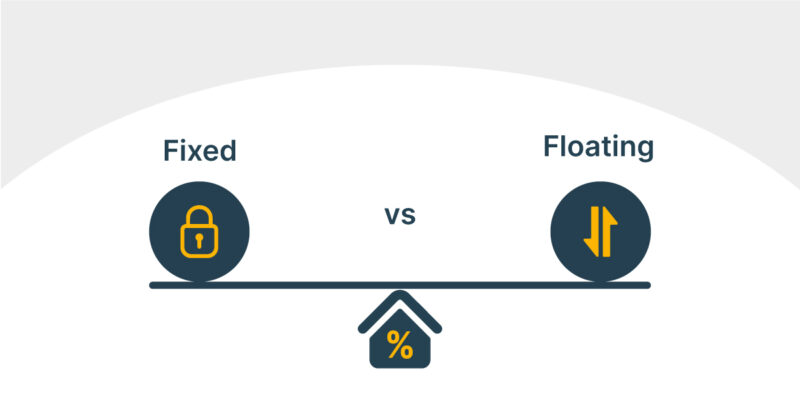Difference Between Fixed and Floating Interest Rate in Home Loan
April 2nd, 2023

A home loan, also known as a mortgage, is a type of loan used to purchase a property. The borrower typically makes a down payment on the property, and then repays the loan with interest over a period of 15-30 years. Interest rates for home loans can be either fixed or floating (adjustable).
There is only one key difference between two types of home loan rates. While the interest rate of a fixed-rate mortgage does not change throughout the life of the loan, the same fluctuates for a floating-rate mortgage – based on a benchmark such as the prime rate.
Choosing the right type of rate for a home loan is important, as it can affect the overall cost of the loan. A fixed interest rate offers predictability and stability in monthly payments, but may have higher initial cash outflow compared to its floating counterpart. The latter may have a lower quantum of payments initially, but it can increase over time, leading to higher monthly payments in later years.
It is important for borrowers to carefully consider their financial situation and future plans, while choosing the type of interest rate for their home loan. Factors to consider may include current rates, the borrower’s income & expenses, and how long they plan to stay in the home. Working with a knowledgeable lender or financial advisor can be helpful in making an informed decision.
Table of Contents
Fixed Interest Rate in Home Loans
The rate remains same for the entire term of the home loan. This means that regardless of any changes in the market or economy, your liability does not fluctuate at any point of time.
Advantages of Fixed Interest Rate in Home Loans
-
Predictable Payments:
One of the main advantages is that it provides borrowers with predictable payments. This allows them to plan and budget more effectively, as they know exactly how much they need to pay every month.
-
Protection Against Rising Rates:
If the borrower or their financial advisor believe that overall interest rates in the market will rise over the long term, it is advisable to get a fixed rate loan. If the rates in the market actually rise, the borrower’s liability will remain the same, and they will not be affected.
Disadvantages of Fixed Interest Rate in Home Loans
-
Higher Initial Rates:
The initial cash outflow for fixed-rate loans or investments is often higher than that of variable-rate options, which can make them more expensive upfront.
-
No Benefit From Falling Rates:
If interest rates fall in the market, borrowers will not see any benefit. They will continue to pay the same amount and may miss out on potential savings.
-
Limited Flexibility:
Fixed rate loans are not as flexible as variable ones. Borrowers may not be able to take advantage of market changes or adjust their payments if their financial situation changes over the long term.
Why Choose Fixed Rate in Home Loans?
These types of loans are often preferred by borrowers because they provide certainty and stability in loan payments. The interest rate remains the same throughout the life of the loan, regardless of any changes in the market or the economy. There are several reasons why someone might choose this type of home loan:
-
Predictability:
You know exactly how much you will be paying each month, which makes it easier to budget and plan your finances.
-
Stability:
A fixed rate will not change over the life of the loan, so you will not have to worry about fluctuations in the market affecting your payments.
-
Protection Against Rising Rates:
Your loan EMI will remain the same even if market rates rise, so you will not be impacted by the increase.
-
Easy Comparison:
Comparing loan offers from different lenders is easier.
Overall, a fixed rate can provide peace of mind and financial stability, especially for those who prefer to know exactly what their monthly payments will be, over the life of the loan.
Floating Interest Rate in Home Loans
Also known as a variable or adjustable rate, this fluctuates over time based on changes in the market. This contrasts with a fixed rate, which remains the same throughout the life of the loan.
Advantages of Floating Interest Rate in Home Loans
-
Lower Initial Outflow:
Here the initial amount is usually lower than that of a fixed-rate loan. This can make it easier for borrowers to fund their monthly payments, especially in the early years of the loan when the paying capacity is lower than that in the later years.
-
Potential Savings:
If rates in the market fall over the life of the loan, borrowers may be able to save money on interest charges.
-
Flexibility:
Borrowers can take advantage of falling rates by paying off their loans early or refinancing at a lower rate.
Disadvantages of Floating Interest Rate
-
Uncertainty:
This is the biggest disadvantage of such loans. Borrowers cannot predict future rates, which means their monthly payments could rise significantly if the rates in the market increase.
-
Higher Risk:
Floating rates are considered to be riskier than fixed ones, as they expose borrowers to potential increases in rates, which in turn depends on the ups & downs of the Indian economy and changes in banking rules as mandated by RBI from time to time.
-
Complexity:
Such loans can be more complex than fixed ones, as they may have more complex terms and conditions that can be difficult for borrowers to understand. Also, it may not be easy to compare these loans across lenders.
Why Choose Floating Interest Rate in Home Loans?
-
Flexibility:
One of the advantages of a floating rate is that it can change over time. This can be beneficial for borrowers who are looking for flexibility in their loan payments. If rates go down, the borrower’s payments will go down as well. On the other hand, if they go up, the borrower’s payments will go up.
-
Lower Initial Amount:
Sometimes, floating loans are initially lower than fixed interest rates. This can make the loan more attractive to borrowers who are looking for lower initial payments.
-
Predicting Rates:
Some borrowers may choose a floating loan because they believe that rates will decrease over time. This can allow them to save money on interest payments in the long run.
Overall, floating interest rates can be a good option for borrowers who are comfortable with some level of uncertainty and are willing to take more risk in exchange for the potential savings and flexibility that they offer. However, borrowers should carefully consider their financial situation and the risks associated with a floating loan, before deciding whether it is the right choice for them.
Fixed Interest Rate |
Floating Interest Rate |
|
Rate remains constant throughout the loan term |
Rate varies regularly as per market conditions |
|
Monthly payments remain the same |
Monthly payments may change as the rate changes |
|
Provides certainty and stability for budgeting and financial planning |
Carries the risk of higher payments in a rising rate environment |
|
Initial payments are typically higher |
Initial payments are generally lower |
|
Good option when rates are expected to rise |
Good option when rates are expected to stay low or decrease |
|
Generally not affected by market fluctuations |
Directly impacted by market fluctuations |
It is important to note that the specific terms and conditions of fixed and floating interest rates may vary depending on factors such as borrower’s credit history, lender’s policies, amount & tenure of home loan. It is important to consider your current & future financial situation and risk tolerance when choosing between these two types of home loans.
Factors to Consider When Choosing Between Fixed and Floating Interest Rates
-
Market Conditions:
Rates fluctuate based on various market factors such as inflation, economic growth, and government policies. If rates are expected to remain stable or decrease in the future, then a floating loan may be a better option. However, if the borrower believes that rates are expected to rise, a fixed loan may be preferred.
-
Risk Tolerance:
Floating rates can be more volatile than fixed ones, meaning that the borrower’s payments can fluctuate significantly. If the borrower is risk-averse or has a limited budget, a fixed loan may be a better option to ensure predictable payments.
-
Loan Term:
The length of the loan can also impact the decision between a fixed or floating rate. A shorter-term loan may be less risky with the floating option. A longer-term loan may benefit from a fixed option, to mitigate the risk of interest rate fluctuations over time.
-
Prepayment Options:
If the borrower plans to pay off the loan early, a fixed rate may not be the best option, as it often includes penalties for prepayment. A floating one may provide more flexibility in this scenario.
-
Credit Score:
Borrowers with higher credit scores may qualify for lower rates, which could impact the decision between a fixed or floating options. In some cases, borrowers may be able to negotiate a better rate by choosing the floating option.
-
Market Competition:
Options offered by different lenders and financial institutions can vary, so it may be worth shopping around to compare rates and terms before deciding.
Overall, the decision between fixed or floating loans should be based on a careful consideration of these and other relevant factors to ensure the best fit for the borrower’s individual circumstances and goals.
Final Thoughts
Typically, home loan is the largest financial liability undertaken by an individual, hence choosing between a fixed and floating interest options is a crucial decision. Both types have their own advantages and disadvantages, and the final decision depends on individual preferences and circumstances.
A fixed rate provides the security of knowing exactly how much you’ll pay each month, which can be helpful for budgeting purposes. It also protects you from sudden increases in interest rates, which can occur with a floating option. However, fixed loan rates tend to be higher than floating ones, which means you may end up paying more money over time.
On the other hand, a floating option can be more affordable in the short term and may offer more flexibility. If interest rates fall, your payments may decrease as well, saving you money. However, if they rise, your payments could go up, making it more difficult to budget.
Ultimately, it is important to carefully consider your financial situation and goals, when deciding between a fixed and floating loans. By weighing the pros and cons of each option and seeking advice from financial experts, you can make an informed decision that helps you achieve your objectives while minimising financial risk.










